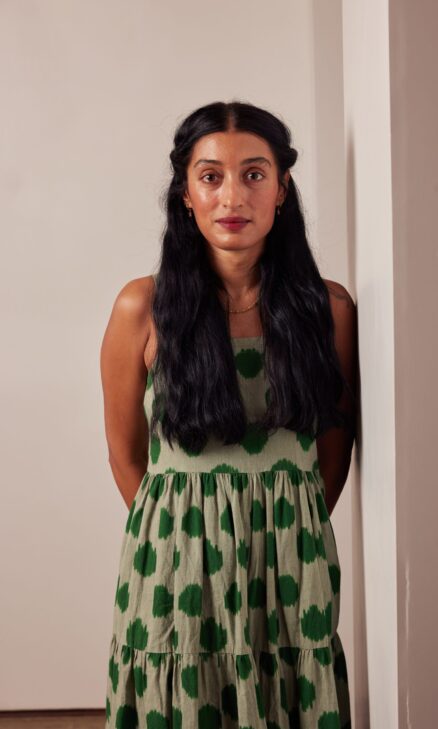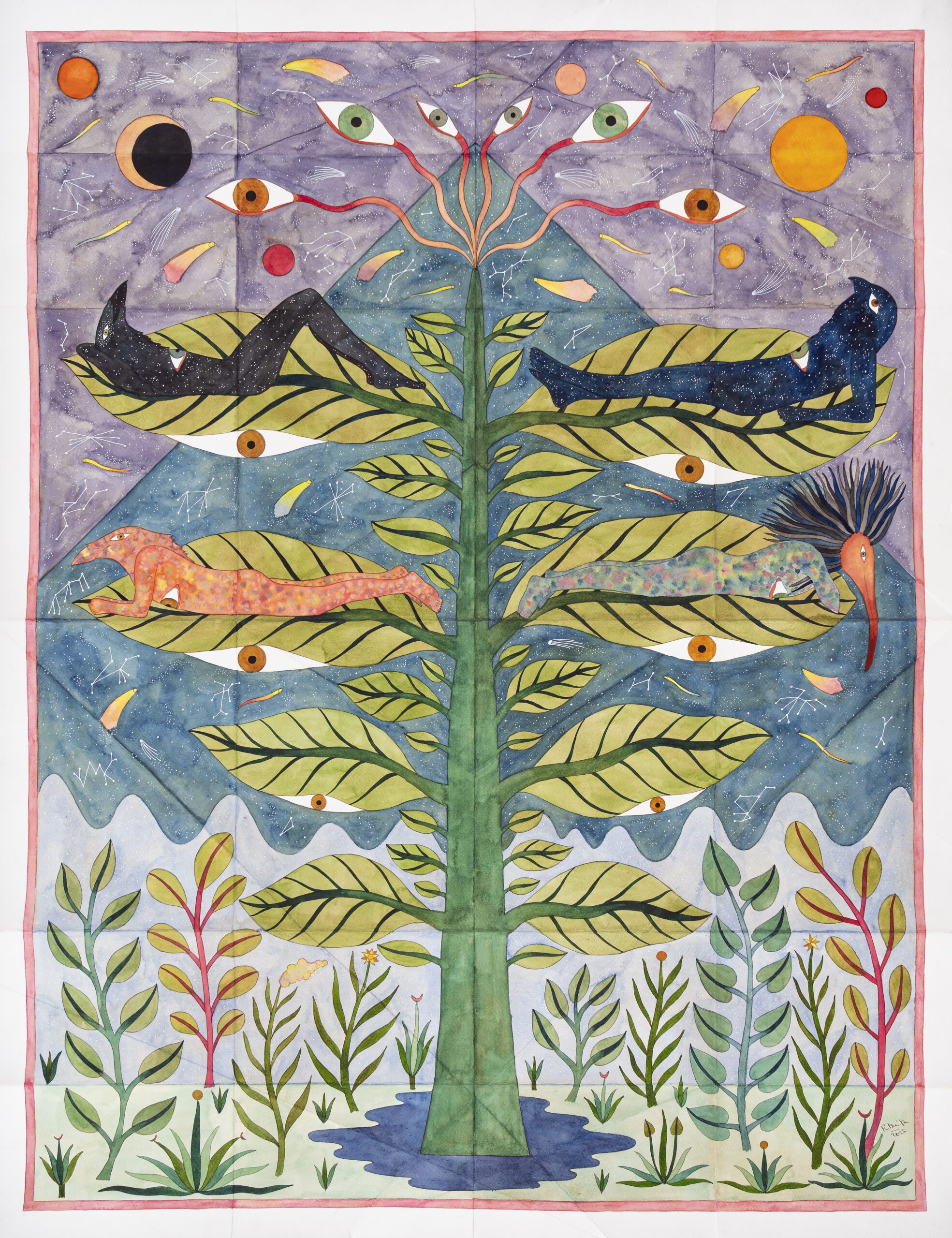Rithika Merchant
In her mythic, otherworldly paintings, Rithika Merchant blurs the lines between folklore and futurism—crafting symbolic worlds where nature, science, and speculative fiction collide in striking gouache compositions that transcend cultural boundaries.
In her paintings, visual artist Rithika Merchant builds a surreal world of her own—populated by mythological symbols and characters, celestial maps, and deep reverence for nature. Brought to life through the gouache technique, her work blends soft yet striking colors like dusty blue, rust, and sage, echoing the look of old manuscripts with a strong sense of folklore. What truly elevates Rithika’s work, however, is her ability to weave elements of science and speculative fiction into her paintings. The intricate compositions not only imagine alternate futures but also draw from the deep-rooted narratives of our collective history and cultural memory. A Fine Arts graduate from Parsons School of Design, New York (2008), Rithika has built a formidable presence on the international art circuit, presenting her work through a series of solo and group exhibitions at prestigious galleries and institutions worldwide. Her early explorations quickly drew attention in countries across borders like Canada and Spain apart from India. Notably, her practice has been featured at some of the world’s leading platforms for contemporary art — including the Queensland Art Gallery & Gallery of Modern Art (QAGOMA) in Brisbane, the Kristin Hjellegjerde Gallery in London and Berlin, and the Dhaka Art Summit in Bangladesh — all renowned for their global footprint and critical acclaim. Beyond the canvas, Rithika’s artistic language has found expression in fashion, collaborating with renowned fashion houses such as Chloé, on multiple collections.This partnership earned her the Vogue India Young Achiever of the Year Award at the Women of the Year Awards in 2018, along with a place on Vogue Magazine’s influential VogueWorld 100 list of Creative Voices shaping global culture. Her most recent series The Flowers We Grew (2025) was commissioned by Maria Graia Chiuri for Dior’s haute couture SS25 show. It comprised of nine intricate paintings reimagined as large-scale textile panels by the master artisans of The Chanakya School of Craft. Much of Rithika’s growing global recognition stems from the universal language that her paintings carry—recurring characters, symbols, and scenes that serve as visual metaphors. Through them, she explores transformation, the interdependence of species and ecosystems, and life’s cyclical rhythms—ideas that transcend cultures. These ideas come to the fore in her latest series at TARQ, Mumbai—a gallery she has been closely associated with since 2011—where symbolic figures like snakes and hybrid bird-like beings echo mythologies from India, Egypt, and Greece.As the contemporary art scene in India continues to grow, artists like Rithika are opening doors to new possibilities, taking India's rich artistic heritage to the global stage—creating work that is compelling enough to blur the lines between geographic and cultural boundaries.


The Observatory, 2025
Gouache, watercolour, ink and gel pen on paper
38.5 x 29.5 inches
Copyright: Copyright Rithika Merchant, 2025
Courtesy: Courtesy of Rithika Merchant andTARQ

AerialSuperstructure I, 2023
Gouache, watercolour and ink on paper
58.2 x 38.5 inches
Copyright: Copyright Rithika Merchant, 2023
Courtesy: Courtesy ofRithika Merchant andTARQ
Rithika speaks to Blur The Border :
Blur : Your art draws from such expansive and contrasting sources—mythology, science fiction, and folk traditions. What draws you to both these worlds and bringing them together in your artworks?
Rithika : Well, I spend a lot of time reading and researching topics that fascinate me, often writing and taking notes as I go. I'm also drawn to fiction and visual art—images and artworks frequently influence my creative process in unexpected ways. My works currently on view at TARQ, have various references and inspirations. For instance, in Zoomorph II I build on the symbolism of snakes across cultures; shedding of old skin and starting anew. It also refers to the ancient myth of Eurynome, who laid the world egg and ordered the cosmic snake to encircle and protect it until it hatched. It envisions architectural structures that embody the snake's cyclical nature of birth, death, and rebirth. While, Aerial Superstructure I and II, draw inspiration from the floating island of Laputa in Gulliver’s Travels—a place steeped in music, mathematics, and astronomy yet disconnected from practical use—as well as Rene Magritte’s The Castle of the Pyrenees.
To me, all forms of art and writing are interconnected, so blending them feels like a natural extension of how I think and create. Some of the books I've really enjoyed recently include the Children of Time series by Adrian Tchaikovsky, Lilith’s Brood by Octavia Butler, and The Vaster Wilds by Lauren Groff.
Blur : Was developing a signature style a conscious choice for you? Do you think its important for artists to have a signature style through which they are recognized?
Rithika : I’ve been inclined to the arts from a young age, and I’ve always seen stories and ideas visually, feeling a compelling need to bring these visions to life. After graduating from college, I spent a lot of time building on my practice, experimenting with materials, and understanding the kinds of narratives I was drawn to, focusing on the strength of storytelling. I was driven to create my own lexicon of symbols and creatures for my narratives. I think for most artists, the primary concern is to keep practicing and to respond sincerely to the ideas or questions that preoccupy them. Over time, through this process, a style or visual language begins to emerge. So, for me, developing on my practice was conscious, but creating a signature style wasn’t a strict conscious goal—it was something that took shape as I kept working and finding my voice.
Blur : Do you have any specific process, habits, or rituals that help you get into a creative mindset?
Riithika : I believe in having a routine; I prefer rising early and a quiet start to the day. My studio is in my house, so I work regularly through the day with productive breaks. Reading and research is also part of my discipline, ranging from fiction to looking at images and art. When I’m feeling creatively blocked, I either take a nap or go for a walk—I’ve come to accept that no one can be productive all the time. An advice I stand by is to show up and work every day, the consistency bears its fruits.
Blur : How does the environment impact your work and fuel your creativity?
Rithika : My studio is my haven, it is quiet and is replete with natural light. The window overlooks trees, and I really value the view. Nature has been a source of inspiration, reflected in the organic forms and colors in my work. I also really enjoy going for walks and spending time outdoors. Since Birth of a New World (2021) I have imagined how our current world becomes uninhabitable and my “beings” (which are proxies of us) coming to terms with what they have done and building a life elsewhere, starting anew. This was kind of a response to climate crises and growing environmental instability. I see my practice as an act of self-soothing, a channel to address my concerns about the state of the world. This exploration continues in the ongoing exhibition at TARQ, Pillars of Fruit and Bone, where I focus on what the architecture of a future world might look like. These imagined structures are rooted in forms from our own world and natural environments, but reimagined as part of a more utopian vision.
Blur : After a decade of practising, how has your art style evolved over the years?
Rithika : Being dedicated to the aspect of storytelling, I feel that the narratives have grown to be more impactful and dynamic. My compositions have evolved to include more symbols and ideas, I spend a lot of time paying attention to the details in each form. While my concerns stem from the same place, it is only in retrospect that I have come to realize how each body of work interacts and relates to each other. I also really like experimenting with new mediums, particularly the various kinds of paper and how they react to how I paint; for some works in Pillars of Fruit and Bone at TARQ, I have used hemp paper which I recently discovered and I’m really enjoying the natural waves and texture that the paper offers.
Blur : Having exhibited across continents—from Paris to Brisbane—what have you observed about how different cultural contexts engage with your work? Is there a particular incident or reaction that has stayed with you?
Rithika : Since my work deals with symbolism and themes that are quite universal, I’ve found that people engage with the work in a similar manner across cultures. I find that across the board they take the time to drink in all the details and really immerse themselves in the work. Watching people of all ages engage with a project I worked on for The Asia Pacific Triennial, Children’s Art Centre really stayed with me. It was wonderful to see how they interacted with my work while being able to almost step into it. The APT11 Kids project builds on the idea of terraformation (which is the process of changing a planet or any celestial body to make it earth like and fit for humans to live on). The idea is for the kids to create a new world by using elements found in my paintings as the building blocks. There is a projected landscape that has been isolated from one of my paintings. The kids are able to add different elements found in my work - creatures, plant life and celestial bodies to this landscape, terraforming and populating a new world. All of the elements are animated, move and react when placed into the landscape.
Blur : How do you navigate the balance between the creative flow of making art and the practical demands of being a professional artist, especially when it comes to managing the administrative and business side of your practice?
Rithika : The galleries I work with handle majority of the marketing, press coverage, and promotion for my work. There are various logistical and back-end processes that transpire after the work is finished, I’m grateful that the galleries I work with take care of it all, leaving me the space to focus fully on my practice.
Blur : In today’s art world, how important is a digital presence for artists, and how do you think emerging artists can harness the power of digital media to build visibility and community?
Rithika : The digital space is so overwhelming and ever growing. At this point, with the multiplicity of options, I think it is a personal choice whether or how one wants to use the digital space. I do think it is a catalyst in building visibility, simply because it fosters interaction with the audience even when you or your work is not physically or always available.
Blur : How do you see the role of fine arts evolving in today's rapidly changing digital landscape?
Rithika : I like to think about how the invention of photography shaped artists to stray away from naturalism and the impressionists were so passionate about how reality is perceived or represented. Through time, photography carved its own niche while some artists continued working in naturalism. With the changing digital landscape as well, a lot of the artists have been doing a fantastic job in bringing technology in their work. It is very practice based, but it is so exciting to see the possibilities it offers!